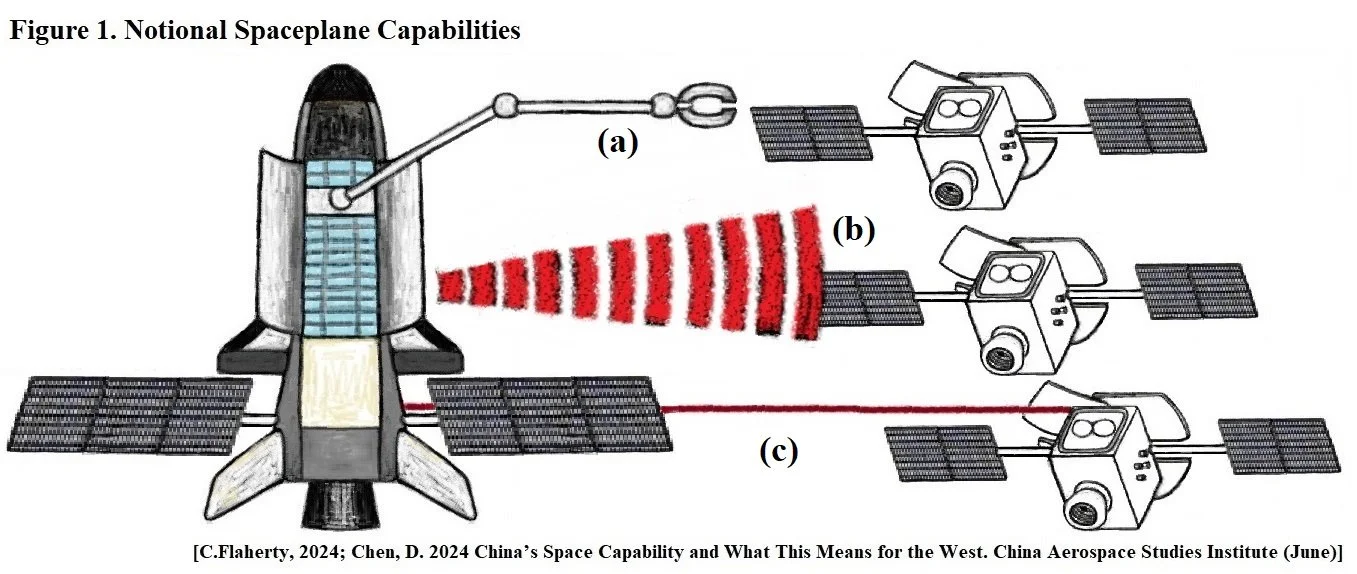SPACEPLANES AND ORBITAL MANOEUVRE WARFARE
▲ U.S. Space Force. 2023 High Ground Intercept. First Official Painting of Space Operations Command (2 November). Public Domain Work (United States).
“The artwork depicts a futuristic U.S. Space vehicle intercepting an adversary satellite, who in turn is positioning to disable a friendly satellite, according to the Space Force. The bay doors of the intercept vehicle are opening as the space plane moves into position and prepares to defend the friendly satellite.” [Trevithick, J. 2023 Spaceplane Vs Satellite Duel in First Space Force Painting is Telling. The War Zone (26 October)]
▲▲ Defense Intelligence Agency (United States Government) graphic, “How One Satellite Might Attack Another in Space”, identifies six attack technologies that could be used: (1) High-Powered Microwaves; (2) Radio Frequency Jammer; (3) Lasers; (4) Chemical Sprayers; (5) Kinetic Kill Vehicle; (6) Robotic Mechanisms [Defense Intelligence Agency. 2022 Challenges to Security in Space]. Nearly all these attacks require a proximity operation - the ability to manoeuvre close to other satellites and deliver the attack. However, there is also a seventh attack technology – ‘Abduction of a satellite’: “During the Shijan 21 mission, a Chinese satellite dragged another satellite to a so-called graveyard orbit (where defunct geostationary-based satellites move to avoid collisions with working satellites) before returning to its original position.” [Suess, J. 2024 You Can’t Hide in Space Anymore: China’s Shenlong Spaceplane. RUSI (20 June)]
CHINA’S SPACEPLANE SHENLONG: The Shenlong: Divine Dragon, has carried out a number of close-proximity manoeuvres since launching in December 2023 [Suess, 2024]. Shenlong’s 2023 mission has been conducting proximity operations with an object it released a few days prior [Suess, 2024]. It was also reported four days after being launched Shenlong placed six objects into Earth orbit, “designated OBJECT A, B, C, D, E and F.” [Tingley, B. 2023 China’s Space Plane Apparently Deployed 6 ‘Mysterious Wingmen’ in Orbit. Space.Com (19 December); Goswami, N. Garretson, P. 2024 The Strategic Implications of China’s ‘Divine Dragon’ Spaceplane. The Diplomat (12 January)] It has been subsequently noted, of the six objects put in orbit, by China’s latest spaceplane, “two … gave off radio signals.” [Chen, D. 2024 China’s Space Capability and What This Means for the West. China Aerospace Studies Institute (June)] Western observers of Shenlong’s Rendezvous and Proximity Operations with its objects, see these as: “capable micro-satellites that were able to maintain station with their mothership.” [Chen, 2024] When the United States first launched its uncrewed reusable spaceplane – the X-37B project, “[Chinese] … analyst speculated about whether it could serve as a platform for grappler arms, high-power microwave weapons, or laser weapons.” [Chen, 2024] This is illustrated in Figure 1. Notional Spaceplane Capabilities▼.
▲ Potential robotic spaceplane combat against satellites in orbit: as a platform for grappler arms (a), high-power microwave weapons (b), or laser weapons (c).
▲▲ In regards to Shenlong’s design, there are: “Two solar panels that can be seen at the end aren’t visible on any of the computer renderings available online.” [David, L. 2024 China’s Secretive Spaceplane Caught on Camera in Orbit (Photos). Space.Com (5 August)]
▲▲▲ “In terms of size, the … [Shenlong] … measures … to be more or less 30 feet (10 meters) in length, which would make it longer than the American X-37B spaceplane” [David, 2024]. It can be assumed the grappler arm, if attached inside the hull cargo compartment, is likely to be around 8 meters long with two limbs (each 4 meters long), with six-degrees of freedom, with a fixed gripper, based on other Chinese designs currently in use [Gao, X.H. et al. 2006 Development of the Chinese Intelligent Space Robotic System. IEEE/RSJ International (9 October)].
Similar to its Chinese counterpart, it is assumed the United States’ X-37B vehicle has previously deployed small satellites directly from the spaceplane [Suess, 2024]. Like the Russian ‘Maytroshka’ Nesting Doll Satellites, spaceplanes carrying unidentified objects in Space and releasing these, are considered to be a type of camouflaging – deception where the hull of the spaceplane is concealing the nature of the smaller satellite(s) inside it. In tactical surprise terms, a spaceplane introduces deliberate uncertainty about what its capabilities and cargo are in Orbital Space:
“Because an adversary may be conditioned to ‘normal’ spaceplane operations; unlike a missile launch, an adversary would not know if a particular spaceplane mission was a threat until it opened its doors. This would greatly reduce the time to react. Spaceplanes could therefore be used as a novel first-strike weapon for a surprise attack.” [Goswami, 2024]
Because a spaceplane can manoeuvre, it means it can threaten multiple assets the opponent values in Orbital Space [Goswami, 2024]. In terms of achieving tactical surprise in Orbital Space, using a spaceplane:
“Thus, a spaceplane can conceal, wait for the right moment, and deploy a variety of small satellites to Low Earth Orbit, which might include imaging and electromagnetic mapping for targeting, missile warning, Space Domain Awareness, or global navigation satellite systems or satellite communication – whatever the tactical situation might demand. It also might contain counterspace co-orbital attack satellites. In principle, it might even contain kinetic kill vehicles for missile defense or launch denial to block a rival’s access to Space, or even space-to-ground kinetic strike munitions. The adversary would not know in advance what is inside, and so the attacker might achieve tactical surprise.” [Goswami, 2024]
Spaceplanes are complete spacecraft with ability to host a variety of payloads, granting ‘flexibility to rapidly integrate and trade out payloads enabling tactical response’; craft could host onboard capabilities, including sensors, radio transmitters, robotic servicing equipment, and even counterspace weapons (jammers, dazzlers, projectile weapons, directed energy weapons, robot arms), that can be manoeuvred to a target in Orbital Space [Goswami, 2024]. A spaceplane’s Orbital Space strategic advantage/use:
“A nation might, for example, signal its seriousness, by placing several loaded spaceplanes into key orbits, carrying payloads or small satellites that might augment, replace, or attack, but keeping them inside the payload bay doors. If the conflict escalates, that nation is in a position to deploy them. If the conflict de-escalates, the nation can show good faith by returning the spaceplanes to Earth – with the added benefit that the satellite spares can be upgraded, serviced, or reconfigured for subsequent challenges. Thus, spaceplanes create new potential for signaling, distraction, and deception.” [Goswami, 2024]
ORBITAL MANOEUVRE ENCIRCLEMENT TACTICS EVOLUTION: Evolving from proximity objects released internally from a spaceplane, or a Maytroshka satellite, or from a robotic arm satellite that carries a secondary targeting satellite on its exterior hull [Gao, 2006], these secondary craft would largely perform the function of increasing situational awareness, as well as targeting – positioning feedback to Ground-based control. It is possible a corralling function, can also be envisaged, where the target satellite has its manoeuvre options limited, or cut-off by the secondary satellite manoeuvring into a blocking position, reminiscent of an Encirclement Tactic commonly seen in terrestrial warfare. This can be visualized in the following model▼.



